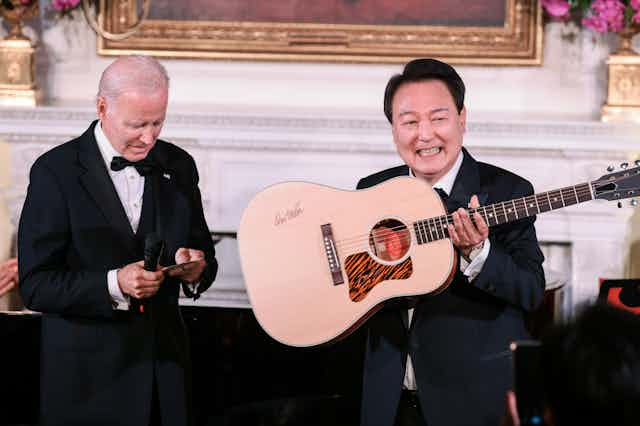The rendition of Don McLean’s classic pop song American Pie by Yoon Suk Yeol may have dominated the headlines as the South Korean president enjoyed dinner at the White House with Joe Biden – Yoon is, reportedly, a devotee of “noraebang”, Korean karaoke. But the frivolity of the moment was a break from the deadly serious purpose of his six-day visit to the US: how to combat the growing regional threat from China and North Korea.
The key takeaway from the visit was what has been dubbed the “Washington Declaration” aimed at bolstering the two countries’ defence alliance in the region.
It is clear from the latest assessment released by the US Office of the Director of National Intelligence that the threat from China and North Korea is seen as critical. The report highlights China’s increasing foreign policy assertiveness and its growing military power. It concludes that: “China is reorienting its nuclear posture for strategic rivalry with the United States because its leaders have concluded that their current capabilities are insufficient.”
The report also forecasts that this year China will increase pressure on Taiwan and ramp up its military presence in the South China Sea.
On North Korea, the report says Pyongyang is “using its nuclear-capable missile programme to try to establish strategic dominance over South Korea and US forces in the region”.
In Seoul, meanwhile, the South Korean political elite is particularly concerned at North Korea’s aggressive posturing on its nuclear ambitions and believes Pyongyang is getting closer to a genuine intercontinental ballistic missile (ICBM) capability. This would threaten the continental US and reduces the credibility of Washington’s doctrine of extended deterrence. This holds that Washington’s commitment to use – if necessary – its nuclear arsenal to deter North Korea from attacking the South means that Seoul has no need for its own nuclear capability.
In January Yoon told South Korean newspaper Chosun Ilbo that he feared that the status quo of extended deterrence was no longer sufficient. He said:
What we call extended deterrence was also the US telling us not to worry because it will take care of everything, but now, it’s difficult to convince our people with just that. The US government also understands that to some degree.
The Washington Declaration aims to address this. Biden and Yoon agreed on a range of measures to enhance nuclear deterrence on the Korean peninsula. These include the establishment of a Nuclear Consultative Group (NCG) to help “plan for nuclear contingencies and cooperate on the Alliance’s approach to nuclear deterrence”.
But, while committing to consultation over “any possible nuclear weapons employment on the Korean Peninsula” the US retains the sole right to decide on the use of nuclear weapons under all circumstances.
In July 2022, Seoul set up a “strategic command” that controls a so-called “precision strike” system for responding to attacks to North Korea. This will now be integrated with the US-ROK Combined Forces Command (CFC). The new agreement also sets out that the two countries will engage in “joint execution and planning for ROK conventional support to US nuclear operations … on the Korean Peninsula”.
This goes at least some way towards the “joint nuclear exercises” that Yoon called for at the time of their first summit in May 2022.
More visible US presence on peninsula
An issue raised in public discourse by politicians and experts prior to the summit was the idea of Washington deploying nuclear weapons on the Korean peninsula – something that would mitigate the need for Seoul to develop its own nuclear deterrent. Under the heading: “More visible US strategic asset deployment”, the new agreement commits to “enhancing the deployment of US strategic assets in and around the Korean Peninsula, in particular US nuclear-capable platforms”.

The words “more visible” are significant here because normally the location and deployment of sea-based nuclear deterrents is kept strictly secret. Biden clarified this in a joint press conference, saying: “we’re not going to be stationing nuclear weapons on – on the peninsula, but we will have visits to – port visits of nuclear submarines and things like that. We are not walking away from that”.
Yoon told reporters at the press conference that he and Biden agreed that the response to a nuclear attack from North Korea would involve the use of “full force of the alliance including the United States’ nuclear weapons. But Biden stopped short of a public commitment to this, instead declaring that "a nuclear attack by North Korea against the United States or its allies or partisans … is unacceptable and will result in the end of whatever regime, were it to take such an action”.
This was a big success for Yoon’s administration. In terms of nuclear consultation, joint exercises, strategic planning and command, he secured about as much as he could have expected from any US president. Whether this will be enough to placate those in South Korea who want a homegrown nuclear capability remains to be seen and will very much depend on what North Korea does next. In spite of the close relationship between Washington and Seoul, engagement on security issues with North Korea remains an urgent priority.

